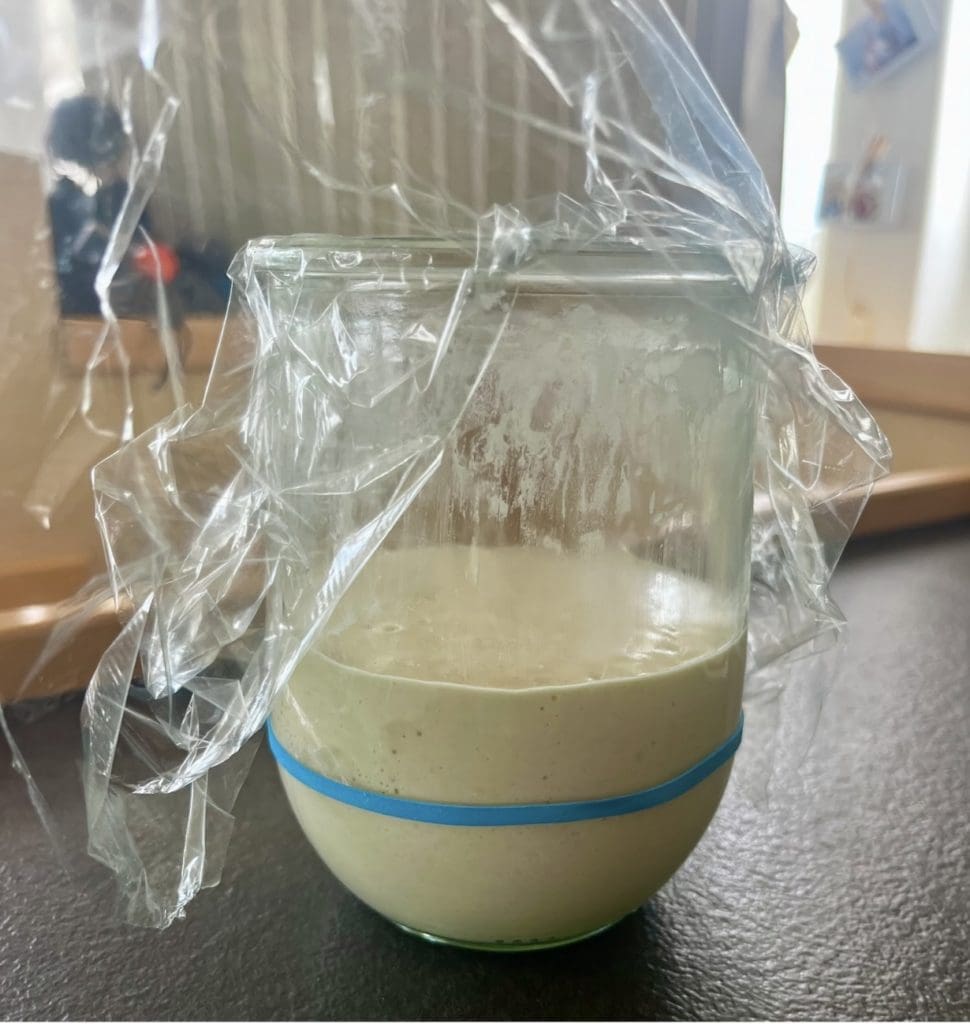Sourdough has always intimidated me. The idea of growing and maintaining a starter without a daily routine as a nomad seemed impractical. However, after switching to lithium batteries and consequently upgrading the oven in our galley, the idea of baking fresh, nutritious goodies was far too tempting! I like to pick up a new hobby/skill every hurricane season to break up the monotony of being “stuck” in one place. So this year, I experimented with sourdough.
Let’s go ahead and get this out of the way: I cheated. I bought this dehydrated starter off Amazon and reconstituted it rather than growing my own from scratch. Using one that was already established gave me a stronger, more resilient starter that was able to thrive despite the high heat and humidity here in the tropics. I followed the instructions it came with for the first four days, using growing proportions of bread flour and water to increase the volume over time. If you’re unsure what type of flour to use in your starter, this article has some great information to help you decide! I fed it each morning —> 24-hour feeding periods, using a rubber band around the base of this wide-mouth jar to mark the starting level and a piece of plastic wrap loosely covering the opening.

I stored it on the counter in a shady part of the galley. After day four, I noticed a small amount of clear liquid forming on the top layer of my starter between feedings. This is called hooch and is an indication that your starter is hungry! I’m assuming the high humidity here caused this, so in response, I decreased the amount of water I used when feeding my starter. For me, the magic proportion ended up being 1/2c starter + 1/2c bread flour + 1/4c and 2tbs water. With this adjustment, my starter began rising (doubling in size) and falling within each 24-hour feeding period. This indicates your starter is ready to bake with!

I began saving and baking with my discard after day ten while still feeding daily. I made a conscious decision to keep my sourdough supplies to a minimum since storage space on our boat is limited. Initially, I was worried about not having a scale or a proofing basket, but I was always able to find recipes with workarounds for those things.
I switched to feeding once a week on day twenty. So, in the afternoon, while my starter was still rising, I would put the lid on the jar and stick it in the refrigerator. I’d let it sit in the fridge, unfed, for a week at a time. The night before I wanted to feed it again, I’d take it out of the refrigerator, remove the lid, and cover it loosely with plastic wrap, allowing it to come to room temperature overnight and feeding it as usual in the morning! My starter became even more active, regularly tripling in size within ~4-6 hours of feeding.

Several months in, I switched to feeding my starter with unbleached all-purpose flour. In a perfect world, I would have continued using bread flour, but I couldn’t find it at the shops where we were anchored. I used the same proportions of flour and water. At first, my starter peaked much later in the day and was lower in the jar than usual. I stuck with it, and things returned to normal after two more feedings.
Overall, I’ve enjoyed dabbling in sourdough this hurricane season, and I plan to continue. I was surprised at how active my starter became, and I am confident in its longevity on the boat moving forward! I feel like it needs a name now. Do you have any ideas? I’ve been thinking “GrenaDough” since I started it in Grenada. The heat and humidity in the Caribbean have prevented me from experimenting much with active starter recipes, though. I don’t have enough space to proof dough in the refrigerator on the boat, and my dough doesn’t rise properly at an ambient temperature of 85°F+. Hopefully, I can try again once it cools down!
Here are a few photos and links to our favorite sourdough recipes:






- I’ve made these with cheddar, pepperjack, and parmesan cheese- they were all great, but cheddar is our favorite!
- I use avocado oil instead of olive oil and a little less flour than the recipe calls for, so they’re easier to roll out thin.
- I also use these to make tortilla chips by cutting them into triangles, spraying them with avocado oil, and air frying at 350° for 8-10mins (flipping halfway). We sprinkle them with flaky sea salt once they’re done!
Sourdough Sandwich Bread (in a bread machine)
- On our bread machine, I select the French setting, dark crust.
How to add sourdough discard to any recipe
- Aside from the above pantry staples, I use discard in any baked goods I make following this method. Some that we’ve mentioned online are my Healthy Banana Nut Muffins and our favorite Double Blueberry Oatmeal Muffins. I typically add 1/2c discard, subtracting 1/4c flour and 1/4c liquid from the recipe.
- I also use discard to thicken gravy/sauces in place of cornstarch or flour!
Let me know what your favorite sourdough recipes are in the comments. Happy baking! 🙂


4 Responses
Name it SabaDough!! I’m going to make those chips this week
Genius!!! Hope you like the chips. 🙂
Hi, this is Gerda from S/V Muti. These look divine, thanks for sharing! Can’t wait to try them! Can you please share the recipe for the chips? Thanks and safe travels!
Hi! For the chips I use the linked tortilla recipe, then cut them into triangles, spray them with avocado oil, and air fry at 350° for 8-10mins (flipping halfway). Sprinkle them with flaky sea salt once they’re done! Hope you enjoy them❤️